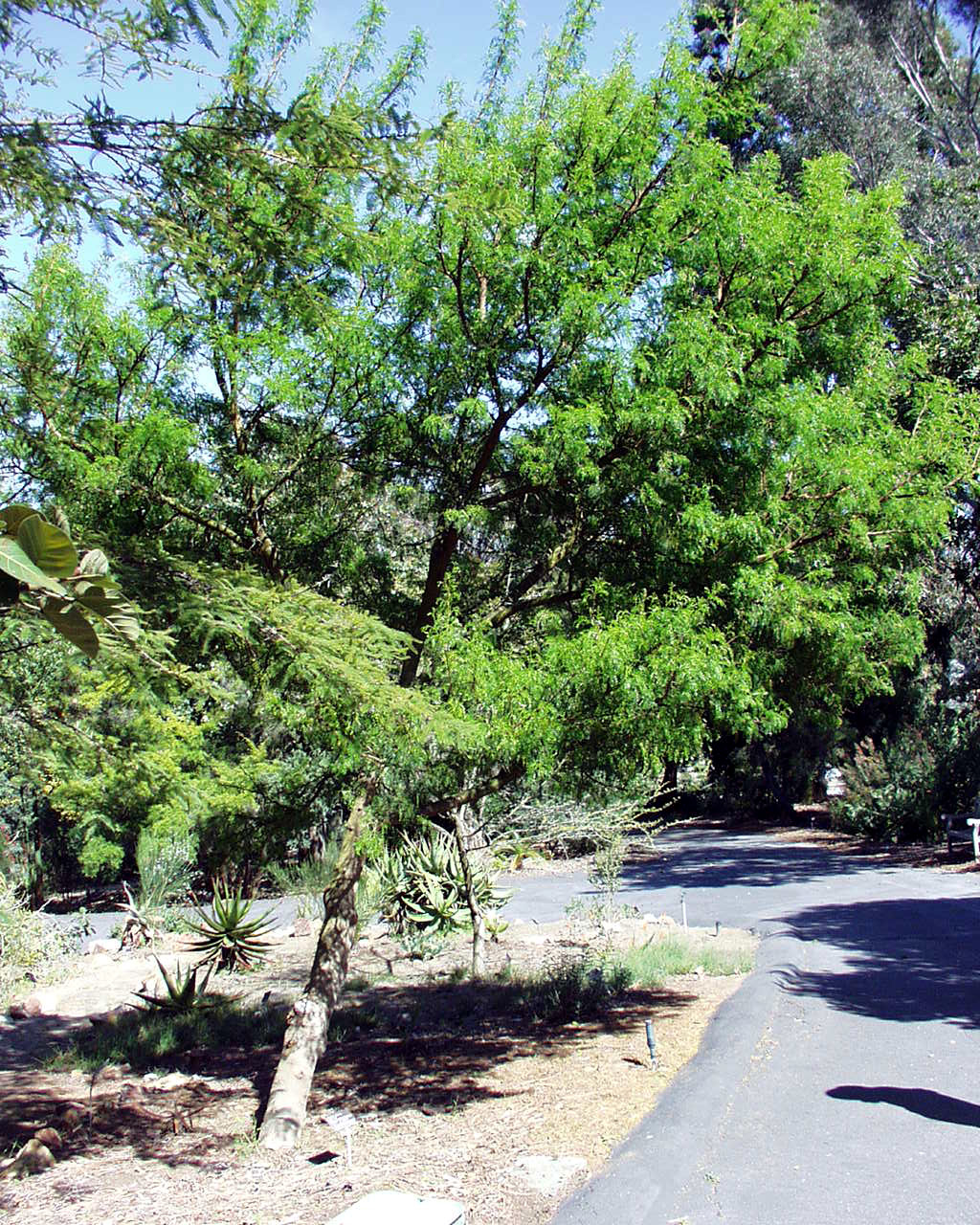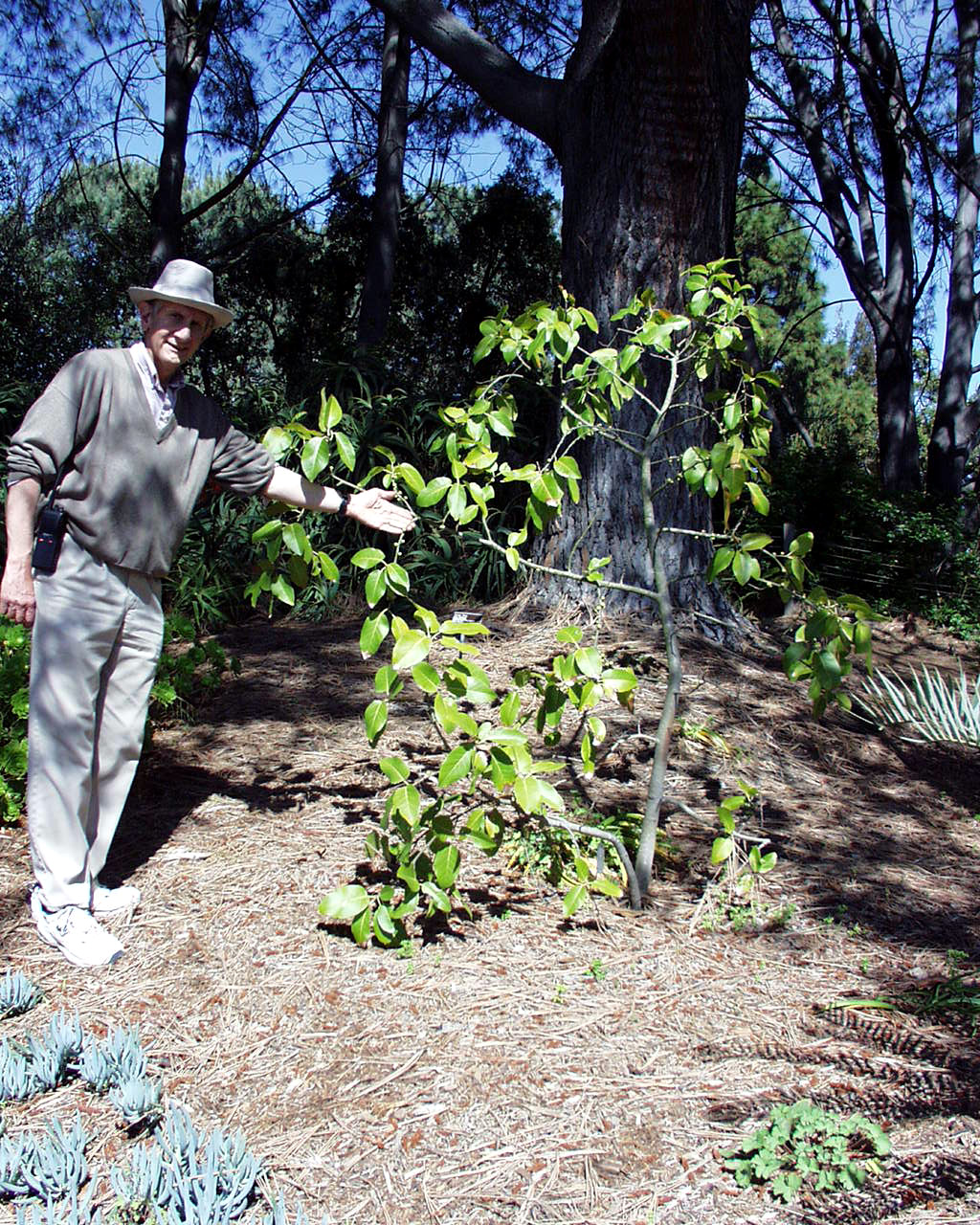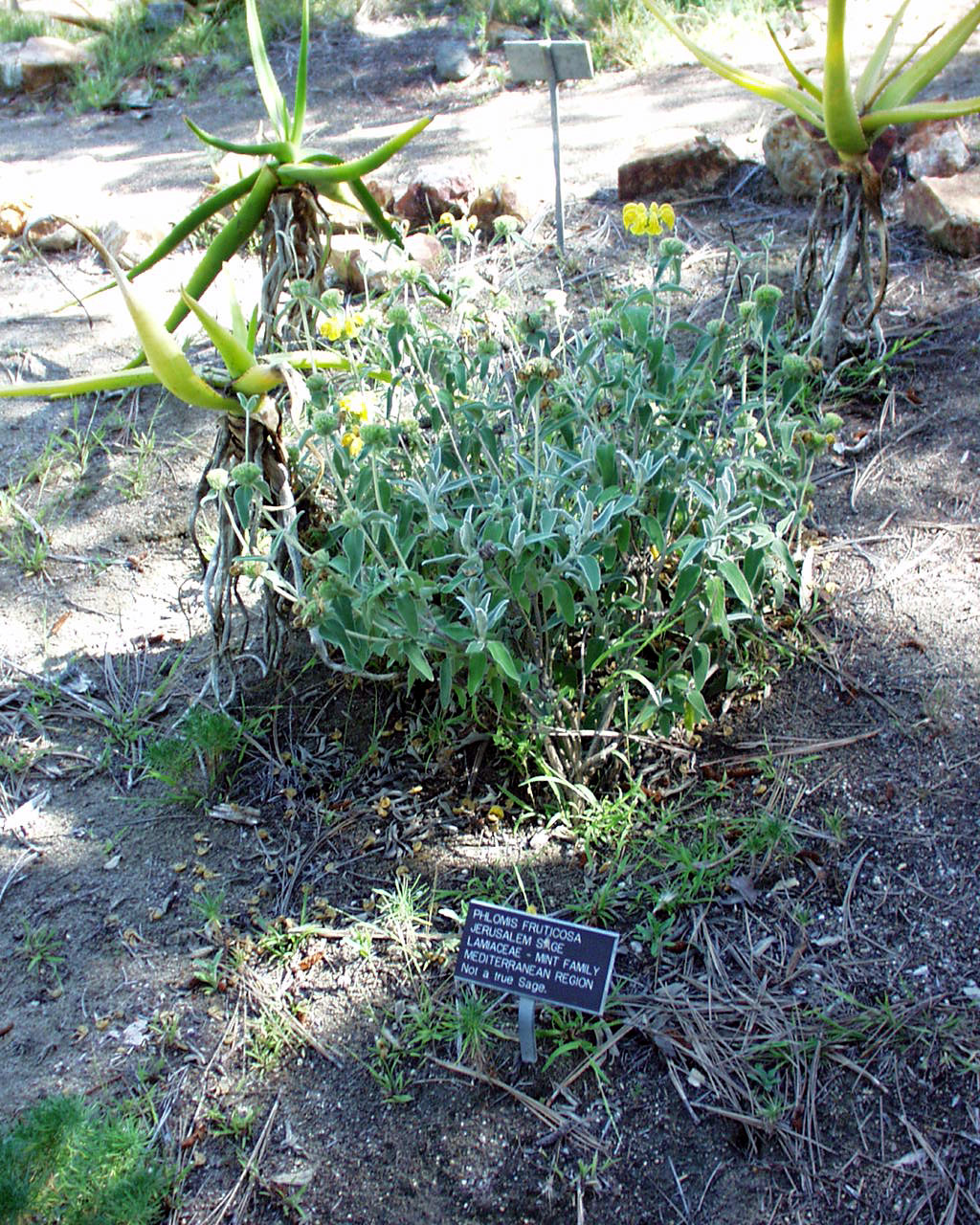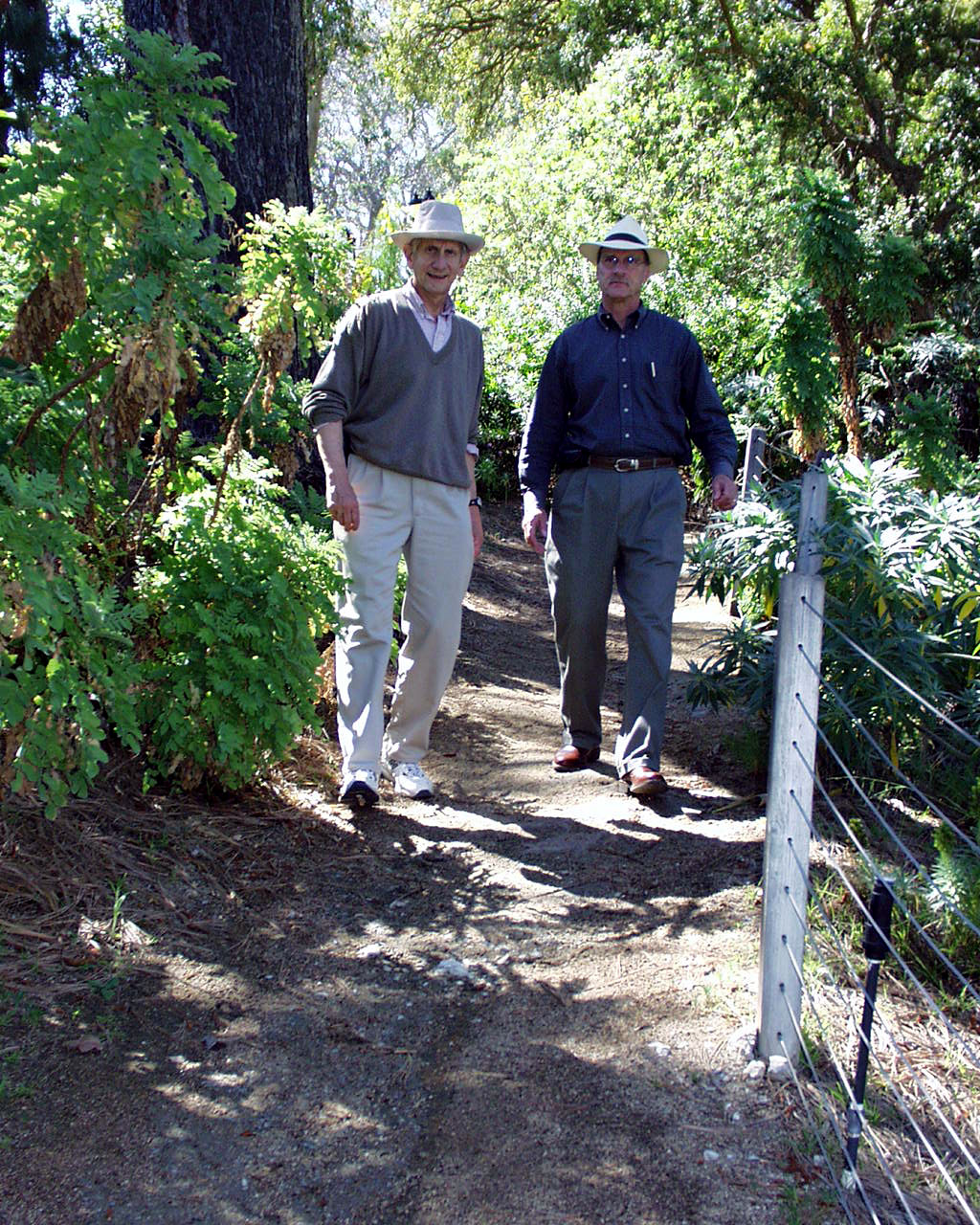|
By Donald H. Harrison
ENCINITAS, Calif..— Through the ages and in various
civilizations, gardens have been planted as special places of meditation, where
man and nature can be brought into harmony. In the Quail
Botanical Gardens, one also can find a plant species here or there that will
bring to mind sections of the Jewish Bible, or Tanach.
There are enough fruit trees in the gardens to furnish a Tu B'Shevat
seder. However, while taking my cousins Marc and Cynthia Yaffe of Maryland
to a growing tourist attraction on Monday, May 21, I found myself focusing
on other kinds of biblical plants.
 In
the garden's Middle Eastern section, for example, one finds acacia trees, or shitim
in Hebrew, which Torah identifies as the wood which God chose for the
Tabernacle. In Exodus 26:15, God commands, "You shall make planks of
the Tabernacle of acacia wood, standing erect. Ten cubits the length of each
plank, and a cubit and a half the width of each plank..." In
the garden's Middle Eastern section, for example, one finds acacia trees, or shitim
in Hebrew, which Torah identifies as the wood which God chose for the
Tabernacle. In Exodus 26:15, God commands, "You shall make planks of
the Tabernacle of acacia wood, standing erect. Ten cubits the length of each
plank, and a cubit and a half the width of each plank..."
In my Stone edition of the Tanach, there is a
footnote addressing the issue of how all those acacia trees got into the Sinai
Desert. It reads: "According to Midrash Tanchuma cited by Rashi (v.
15), the Patriarch Jacob anticipated the need for such lumber in the Wilderness.
He planted these trees in Egypt and instructed his children to take the wood
with them when they left their exile."
Later, after the Ten Commandments were received at Mount Sinai, Exodus 37:1
relates that "Bezalel made the Ark of acacia wood, two and a half cubits
its length, a cubit and a half its width, and a cubit and a half its
height."
Illustrated Dictionary & Concordance of the Bible, edited by Geoffrey
Wigoder, observes that "the most common species (of acacia) found today in
the Sinai Peninsula is a thorny tree with yellow flowers Its trunk is
generally thin and this makes it difficult to identify with the acacia of the
Bible..."
Nowadays, more people probably have Raiders of the Lost Ark,
the 1981 movie starring Harrison Ford, as a frame of reference for imagining
this holy vessel than they do this particular passage from scripture. No
matter, here at Quail Botanical Gardens, if one is so inclined, one may imagine the acacias planted by Jacob, fashioned by Bezalel or sought by
"Indiana Jones," the character portrayed by Harrison Ford.
 In
the Africa section of Quail Botanical Gardens one can find a sycamore fig tree
sapling, which Dave Ehrlinger, the chief horticulturalist, notes has a soft
wood, easy to work. In biblical days, "they didn't have fancy tools , so
the soft wood was what they wanted," he said. "The Prophet Amos
was a tender of figs." In
the Africa section of Quail Botanical Gardens one can find a sycamore fig tree
sapling, which Dave Ehrlinger, the chief horticulturalist, notes has a soft
wood, easy to work. In biblical days, "they didn't have fancy tools , so
the soft wood was what they wanted," he said. "The Prophet Amos
was a tender of figs."
The Stone edition of the Tanakh words that a
little differently. In 7:14, Amos declares that he is not a professional
prophet but rather "I am a cattle herder and an examiner of
sycamores."
Tending? Examining? What's it all about? Ehrlinger explained
that sycamores have a more difficult time reproducing than trees of other species.
"Male flowers have to pollinate the female flowers, but not on the same
tree, or it won't pollinate, so there was a specialized group of people like him
(Amos) who would go around from farm to farm and they knew how to do the
pollination... In addition he probably pruned and fertilized them."
Amos and other sycamore specialists must have done a good job, particularly
in the Negev and along the coastal plain because they were the basis of a simile
for growing in abundance. The Concordance reports that King Solomon
"made cedars as abundant as the sycamores which are in the lowland (1 Kgs
10:27).
Before joining the Quail Botanical Gardens staff four years ago, Ehrlinger
worked at the Cincinnati Zoo, where, thanks in large measure to the Jewish
community there, they have a biblical garden.
 During
our walk through the gardens, Ehrlinger also spoke with me about the
"Jerusalem sage " He was not referring to King David nor to King
Solomon, although surely the latter may have deserved the nickname. He was
talking about a popular name for a shrub which blooms with yellow flowers and
which is not a sage at all but a member of the mint family bearing the scientific
name phlomis fruticosa. During
our walk through the gardens, Ehrlinger also spoke with me about the
"Jerusalem sage " He was not referring to King David nor to King
Solomon, although surely the latter may have deserved the nickname. He was
talking about a popular name for a shrub which blooms with yellow flowers and
which is not a sage at all but a member of the mint family bearing the scientific
name phlomis fruticosa.
Despite its romantic common name, the Jerusalem sage does not get a word in the
Tanakh, although there are references in Christian Scripture to mint. Ehrlinger said that "the true sage has been
grown in Israel for thousands of years, just as these old-time agriculturalists
thousands of year ago grew, for culinary and medicinal purposes, thyme, rosemary,
and lavender."
To learn more about the Jerusalem sage, I went online to the
B&T World Seed catalogue and learned that there are three plant species referred
to by that name: Phlomis fruticosa, Pulmonaria officinalis and Salvia
hierosolymitana. Pulmonaria is so named because it looks like lung
tissue. Salvia refers to sage. Hmm, a mint, a lung tissue-like plant,
a sage;I found myself wondering which one might be Orthodox, which
Conservative and which Reform.
 Julian
Duval, executive director of the Quail Botanical Gardens, said getting people
back in touch with nature is a paramount mission. A former vice president
for botanical collections for the Indianapolis Zoo, he came to Encinitas about a
year after a non-profit organization agreed to administer the gardens, which
previously had been tended by the San Diego County government. With the
county in a budget crunch, the gardens were not being kept up properly. Julian
Duval, executive director of the Quail Botanical Gardens, said getting people
back in touch with nature is a paramount mission. A former vice president
for botanical collections for the Indianapolis Zoo, he came to Encinitas about a
year after a non-profit organization agreed to administer the gardens, which
previously had been tended by the San Diego County government. With the
county in a budget crunch, the gardens were not being kept up properly.
The gardens, named for a bird which frequented the area, had
been owned by Charles and Ruth Larabee during the first half of the 20th
century. Following their divorce, Ruth Larabee deeded 30-acres and their
modest home in 1956 to the San Diego County government, which didn't open the
gardens for regular public visits until 1971. Bamboo species imported to
California were quarantined for a year at the Quail Botanical Gardens to guard
against the introduction of new pests that might attack cereal crops in the
state. The American Bamboo Society was founded at these gardens in
1979.
Ehrlinger and Duval
After Duval's arrival in 1995, he began renovating the gardens. He
created a Canary Islands area from plants native to that island chain off the
Atlantic Coast of North Africa. Next he created a bamboo display garden,
then a subtropical fruit area, and, after that, a tropical rain forest area,
built around a small waterfall feature already on the property. In one area of
the gardens would pass through acres of indigenous coastal sage and would ask
"when are you planning to do something here?" Duval said he
realized that visitors needed to be educated that the plants from this region were as interesting as plants from elsewhere.
He helped to create a "native plants, native people"
exhibit, in which visitors learn not only about the plants but how the Kumeyaay
Indians of San Diego County utilized those plants. Jane Dumas, a Kumeyaay
elder, showed Duval and his staff the gardens in a way he had never seen them
before, stopping here and
there to explain the different uses for various plants, ranging from use in
baskets, huts and other weavings to herbs, medicines, seasonings and food
staples.
"Seeds of Wonder," a garden where children can wander around amid
fanciful sculptures and topiary is one of Duval's favorite projects because he
believes the gardens can inculcate children with a love for nature. When
he was a boy, he said, children used to play outside. Today, they seem to prefer
to play indoors with computers and other electronics, and, as a result, go
outside very seldom. "Why do you think we have so much obesity?"
he asks.
The most recent garden to be created showcases succulents which store water and are fire-resistant. Fires always are a concern in Southern California, where native
chaparral tends to dry into tinder during the summer months. The roofs of
two utility buildings are covered with succulents t demonstrate how one
of the most vulnerable parts of a structure can be protected from
wildfires. Not only that, says Duval, but the rooftop succulent gardens
prevent water from running off the roofs to the sewers and then out to sea,
thereby reducing pollution in the ocean.
So far, he said, insufficient attention has been given to the Middle Eastern
garden. However, he said, thinking aloud, both the Indianapolis Zoo and Cincinnati Zoo had biblical gardens. Maybe that is an idea
worth pursuing.
Admission to the facility, easily reached by going east from the Encinitas
Boulevard exit of Interstate 5, is $8 for most adults, $5 for seniors, military
personnel and students, and $3 for children under 12. The Quail Botanical
Gardens are open daily
from 9 a.m. to 5 p.m.. Its website is www.qbgardens.org
|

